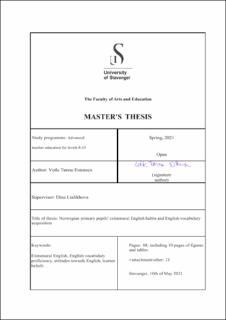| dc.description.abstract | Abstract
This thesis is a study on Norwegian sixth graders’ extramural English (EE) habits and their English vocabulary acquisition. The main aim of the thesis was to map Norwegian sixth graders’ exposure to EE, the types of EE activities the pupils were engaged in, and how a high amount of exposure to EE activities could possibly relate to vocabulary proficiency in English. In addition, the pupils’ attitudes towards English and beliefs about their own learning of English were in focus.
The data for the study was gathered through a mixed methods approach. More specifically, a language diary, a vocabulary test, and a digital mixed questionnaire collecting both qualitative and quantitative data were used in this study. The study was conducted on 45 sixth graders, and as a result of the changing climate of Covid-19, the data was collected at only one urban primary school in Norway.
The study identified a pattern that showed a relationship between high EE exposure and the pupils’ English vocabulary proficiency. Yet, some EE activities might be more beneficial for L2 vocabulary acquisition than others. The findings also revealed that on average the pupils spent roughly 25.1 hours per week on EE activities. However, it should be noted that this number may be exaggerated, as the reported data relies on self-report from younger learners, and, therefore, it would be reasonable to assume that some estimates could have been approximate. In addition, the majority of the pupils in the study believed they learned most of their English outside of school, and that EE activities were the most important type of activities for them to develop their English skills. Among the reported EE activities, playing digital games was the most popular activity, followed by TikTok and watching (films, TV series, and videos). In contrast, reading turned out to be the least popular activity. Lastly, the data demonstrates that attitudes and beliefs might relate to the learner’s English proficiency.
This thesis has contributed to a growing body of research on the benefits of EE, which has so far been more extensive especially in the Swedish context (Sundqvist, 2009; Sundqvist & Sylvén, 2012, 2016; Wickström & Sundqvist, 2015). However, in Norway, there are still only a few studies conducted on the topic (Jakobsson, 2018; Dahl, 2019; Reda, 2019). To the best knowledge of the researcher, this thesis is the only study concerning EE and its benefits on younger language learners in the Norwegian context. The thesis has along with other research studies acknowledged EE as a factor influencing English language acquisition, especially English vocabulary acquisition. Having knowledge about EE and its potential influence, if used correctly, it could help English as a Foreign Language (EFL) teachers in optimizing their classroom practices for the specific needs and interests of their pupils, which could, in turn, make the EFL classroom more motivating. As research has shown, motivation is a prominent factor for successful foreign language acquisition (Krashen, 1982; Dörnyei, 2005; Sundqvist, 2009). | |
